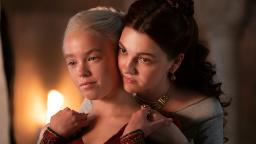Editor’s Note: The following contains spoilers about the premiere episode of “House of the Dragon.”
CNN
—
Medieval-style medicine obviously had its limits. But a pivotal moment in the “House of the Dragon” premiere will likely resonate for many in a way that goes beyond the realm of fantasy and touches upon real-world concerns about women’s reproductive rights.
In the opening chapter of the HBO series, the queen, Aemma Targaryen (Sian Brooke), is in the midst of a difficult labor. Her husband, King Viserys Targaryen (Paddy Considine), is desperate for a son in order to secure a male heir to the throne, in accordance with tradition.
Told that the baby is a breach birth, the medical advisers say that the king faces a terrible choice, one that will require either losing the baby, or sacrificing the life of the mother in order to try saving it.
After agonizing for a time, the king chooses the latter, with the blood loss from the grisly procedure killing the queen.
Earlier in the episode, Aemma refers to women giving birth as “our battlefield,” and thanks to the limited tools of the time, that’s particularly true in the show’s reality. As the Hollywood Reporter’s James Hibberd put it, “the first season does for giving birth what ‘Game of Thrones’ did for weddings.”
While the series is cast as a fictional fantasy, it’s impossible to entirely divorce that from the discussion about abortion since the Supreme Court overturned Roe v. Wade in June, fueling fierce debate about issues of forced birth and women’s freedom to make their own healthcare choices. Here, it’s the husband (and not incidentally, the head of state) who ultimately decides for her, with the most dire of consequences.
The fact that the baby later dies doesn’t erase Viserys’ actions, although it does eventually prompt him to designate his daughter, Princess Rhaenyra (Milly Alcock), as his heir, despite the break with tradition that entails, and the expectation that a future son, born to a new queen, will prompt him to supplant her.
At its core, as the producers have acknowledged, the first season of “House of the Dragon” hinges on questions associated with a patriarchal society, one where sons are preferred in the pressure to secure royal bloodlines, and chaos and discord can ensue without such clear lines of succession.
Addressing those themes, executive producer Miguel Sapochnik has said a fundamental tension within the series is “the patriarchy’s perception of women,” noting that exploring such material – including the decision to anchor the story around its female characters – “made this show feel more contemporary.”
Although the primary mission is presenting an earlier chapter in author George R.R. Martin’s struggles for the Iron Throne, the producers were clearly mindful of early criticisms of “Game of Thrones.” That included incorporating people of color into the “House” cast and, as Salon noted, employing a more restrained approach in depicting sexual violence.
Obviously, the scale and setting of “House of the Dragon” suggests that it is seeking to appeal to a variety of audiences on different levels, including spectacle, escapism, and its relationship to the mythology contained in Martin’s writing and the earlier series. But drama has a way of touching upon matters relevant to our lives even when it’s set in the past, future or some alternative version of reality.
So in terms of writing the series off as sheer fantasy, as the premiere suggests and future episodes will reinforce, don’t let the dragons fool you.


